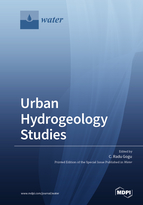Urban Hydrogeology Studies
A special issue of Water (ISSN 2073-4441). This special issue belongs to the section "Hydrogeology".
Deadline for manuscript submissions: closed (31 December 2021) | Viewed by 42017
Special Issue Editor
Interests: urban hydrogeology; groundwater modelling; groundwater engineering; urban soil hydraulic assessment, remote sensing, geospatial information; water resources engineering; contaminant transport hydrology
Special Issues, Collections and Topics in MDPI journals
Special Issue Information
Dear Colleagues,
Urbanization worldwide is the predominant global phenomenon of our time, therefore sustainable urban development is now one of the greatest challenges faced by the contemporary world. The subsurface plays a range of roles in the complex process of urbanization, including buildings development, constructing transportation roads, providing water-supply, drainage, sanitation and in some cases solid-waste disposal.
For most of the cities, the groundwater system commonly represents a ‘linking component’ between various elements of the urban infrastructure. Since urban processes has an influence on groundwater and groundwater conditions has an impact on the urban infrastructure, groundwater systems exhibit a close relation with the processes of urbanization and this continuously progresses with the urban development cycle. Consequently, most cities around the world face issues related to urban hydrogeology, requiring attention at least as much as those provided by other planning related problems in urban areas.
Urban groundwater problems are now usually predictable. However, they are not predicted early enough, as actions usually respond to emergencies rather than planning. Consequences resulting from a lack of accurate and detailed knowledge of the underground environment and the interaction between the urban groundwater and urban infrastructure is faced by cities of the entire world in economic, environmental, social, legal and political terms.
The lack of data and planning as well as the discrepancies in communication between the scientific community and city managers increase difficulties in solving urban hydrogeology problems. To supply this understanding, the experts have to use robust datasets of urban fabric, infrastructure networks, groundwater and geothermal energy systems at city-scale. Furthermore, relevant knowledge and understanding from these must also be accessible to urban planning processes.
During the last decades a progressive advance in the scientific understanding of urban hydrogeological processes and the groundwater regimes of a substantial number of cities, has been documented. This extensive palette of subsurface challenges which cities have to contend with, lay at the core of the sustainability of the urban water cycle. This is threatened by the increasing scale and downward extent of urban subsurface construction, including utilities (cables, sewage, drainage), transportation (tunnels, passages), and storage (cellars, parking lots, thermal energy). The cumulative impact of this subsurface congestion on the surrounding geology, and especially the groundwater system, have to be persistently studied.
Key connections amongst the urban hydrogeology activities will be identified as consistent scientific results and good practice in relationship to subsurface data knowledge. The volume will encourage both cross- and trans-disciplinary, mutually beneficial dialogue between the providers and consumers of urban groundwater data and knowledge offering new perspectives on the existing research themes.
Prof. C. Radu Gogu
Guest Editor
Manuscript Submission Information
Manuscripts should be submitted online at www.mdpi.com by registering and logging in to this website. Once you are registered, click here to go to the submission form. Manuscripts can be submitted until the deadline. All submissions that pass pre-check are peer-reviewed. Accepted papers will be published continuously in the journal (as soon as accepted) and will be listed together on the special issue website. Research articles, review articles as well as short communications are invited. For planned papers, a title and short abstract (about 100 words) can be sent to the Editorial Office for announcement on this website.
Submitted manuscripts should not have been published previously, nor be under consideration for publication elsewhere (except conference proceedings papers). All manuscripts are thoroughly refereed through a single-blind peer-review process. A guide for authors and other relevant information for submission of manuscripts is available on the Instructions for Authors page. Water is an international peer-reviewed open access semimonthly journal published by MDPI.
Please visit the Instructions for Authors page before submitting a manuscript. The Article Processing Charge (APC) for publication in this open access journal is 2600 CHF (Swiss Francs). Submitted papers should be well formatted and use good English. Authors may use MDPI's English editing service prior to publication or during author revisions.
Keywords
- Urban hydrogeology
- urban water balance
- groundwater infrastructure interaction
- groundwater modelling
- urban geothermal energy
- groundwater quality
- remote sensing
- geospatial analysis
- urban soils






